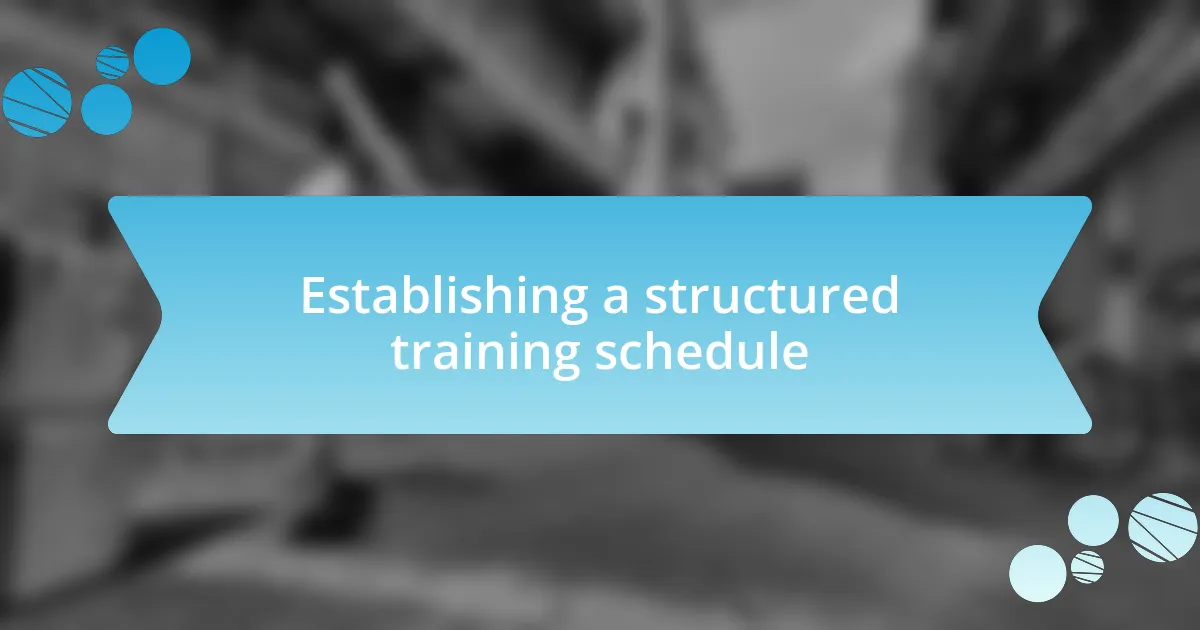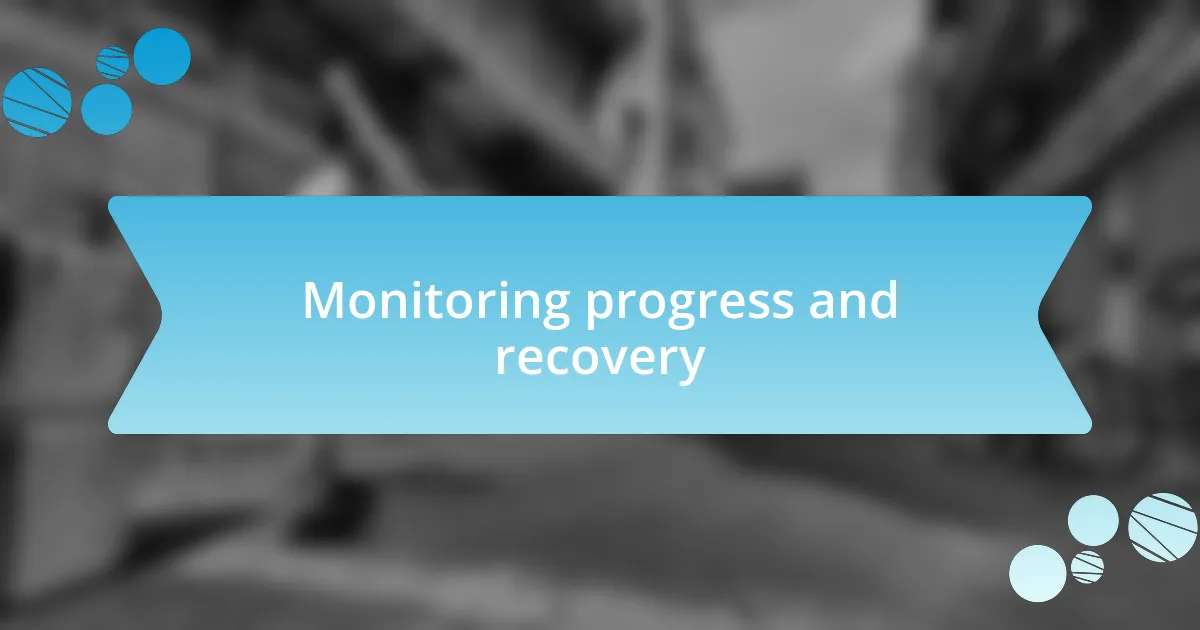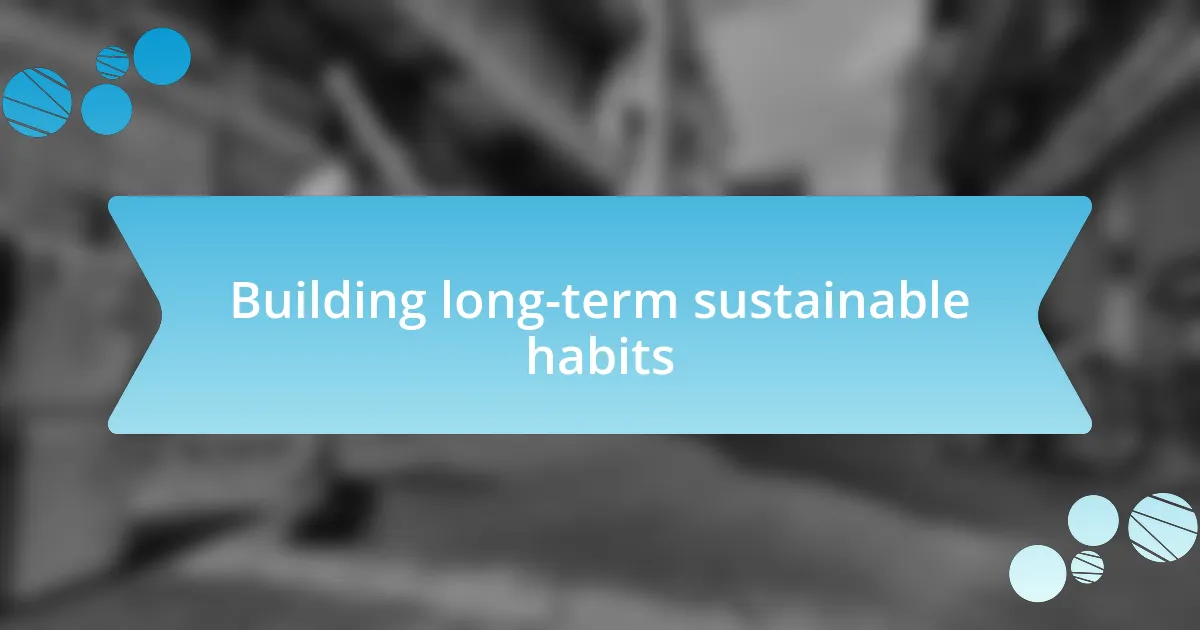Key takeaways:
- Finding balance between training and rest is essential for recovery and long-term success.
- Setting clear, personalized training goals enhances focus, motivation, and progress tracking.
- Establishing a structured training schedule and incorporating rest strategies improves performance and prevents burnout.
- Monitoring progress and being receptive to feedback enables necessary adjustments and fosters sustainable habits.

Understanding the importance of balance
In my own experience, finding balance between training and rest was often a challenge. I vividly recall a time when I pushed through fatigue, thinking more was better, only to find myself overwhelmed and unmotivated. This taught me that rest isn’t just a break; it’s essential for recovery and growth.
Have you ever felt that rush of excitement before a big workout, only to crash later? I’ve been in that position, ready to conquer a demanding routine, but neglecting my body’s need for recovery led to burnout. I learned that balance isn’t merely a suggestion; it’s a necessity for longevity in any training regimen.
What I’ve discovered is that balance allows us to appreciate our progress and keep the passion alive. By intentionally blending hard work with restorative practices, I’ve managed to cultivate a sustainable routine that enhances both performance and well-being. Isn’t it fascinating how a structured approach to training and rest can transform our mindset and results?

Identifying personal training goals
Identifying personal training goals is crucial for any successful training journey. When I began my fitness journey, I made the mistake of adopting generic goals without considering my specific needs and aspirations. Over time, I learned that articulating clear, personal objectives—like running a 5k without stopping or increasing my deadlift by a certain weight—provided me with focus and direction.
One of my most eye-opening experiences was during a training session where I felt completely lost. I had no specific goal, just a vague desire to “get fit.” It wasn’t until I wrote down my objectives that the fog lifted. Setting distinct goals helped me track my progress and stay motivated. I can’t stress enough how invaluable setting personal, measurable goals can be in creating a meaningful training plan.
Understanding your unique motivations is equally important. For instance, if you’re training to improve your mental health, your focus may differ from someone training for a competition. When I aligned my training with my emotional needs, I found I was not only more consistent but also more fulfilled. It’s about embracing the individual journey rather than following a one-size-fits-all approach.
| Characteristic | Importance |
|---|---|
| Clarity | Gives direction to your training plans. |
| Measurability | Allows tracking and adjustment of goals. |
| Personalization | Aligns training with emotional and physical needs. |

Establishing a structured training schedule
Establishing a structured training schedule is a game-changer when it comes to balancing training and rest. I vividly remember a time when my training felt more like chaos than progress. I was jumping from one workout to another without any plan, leading to burnout rather than gains. It was only after I committed to a consistent schedule, mapping out my workouts and rest days, that I began to see real improvement. A well-structured training schedule not only helps in avoiding injuries but also brings clarity to your fitness journey.
Here are some crucial elements to consider when creating your training schedule:
- Consistency: Choose specific days and times to work out, making it a non-negotiable part of your routine.
- Variety: Include different types of workouts to target various muscle groups and keep things interesting, like strength training, cardio, and flexibility work.
- Rest Days: Strategically place rest days to allow your body to recover and prevent overtraining.
- Flexibility: Be open to adjusting your schedule as needed based on how you’re feeling physically and mentally.
- Tracking Progress: Keep a record of your workouts to identify patterns, achievements, and areas needing improvement.
By implementing a structured approach, I found a rhythm that not only matched my goals but also enhanced my overall well-being. There’s something empowering about knowing exactly what you need to do and when, which ultimately supports sustained motivation and success in your fitness journey.

Incorporating effective rest strategies
Incorporating effective rest strategies can be transformative for anyone trying to balance training and recovery. I remember my first experience of overtraining, where I thought pushing harder would yield better results. Instead, I found myself feeling drained and unmotivated. By intentionally scheduling rest periods, I discovered the power of letting my body recover. It was a revelatory moment; I realized that sometimes, less truly is more.
One effective strategy I embraced is the concept of active rest. This means incorporating low-intensity activities on days I felt tired or sore. For example, I began taking leisurely walks or practicing yoga instead of diving into a strenuous workout. It not only kept me moving but also allowed me to recharge mentally. Have you ever noticed how a change of pace can refresh your mindset? I found that these mindful rest days actually enhanced my training sessions, making them more productive when I returned to them.
Another key strategy is listening to my body. I’ve learned to recognize signs of fatigue and to trust my instincts. There were times I pushed through fatigue, thinking that I was being tough, but it often backfired, leading to injuries or setbacks. Now, when I feel that telltale heaviness in my limbs, I consciously choose to rest instead of risking burnout. This shift in perspective has been crucial in my journey—how can we expect our bodies to perform optimally if we don’t give them the care they need? Embracing rest as an essential component of my training has truly been a game changer.

Monitoring progress and recovery
Monitoring progress and recovery has been instrumental in refining my approach to training. I remember tracking my energy levels after workouts, using a simple journal. It surprised me how just writing down my feelings helped me identify patterns—certain workouts left me exhilarated while others left me exhausted. Have you ever wondered how reflecting on your experiences could change your training trajectory? This practice allowed me to adjust my routines, ensuring I wasn’t just pushing limits but also respecting my body’s signals.
In addition to journaling, I incorporated feedback tools like heart rate monitors. Initially, I was skeptical about whether this data could enhance my training experience. However, I quickly discovered that monitoring my heart rate gave me insights into my recovery time after intense sessions. I remember a period when I was consistently hitting high-intensity workouts; my heart rate showed that I wasn’t recovering adequately. This revelation led me to reassess my training plan, embracing lower-intensity sessions and prioritizing recovery, which ultimately improved my performance.
Another valuable aspect of monitoring is assessing how I felt both physically and mentally before and after workouts. There were days when I would dread my training sessions, thinking I had lost my edge. But upon checking in with myself, I realized it was fatigue talking, not lack of motivation. Have you ever had those moments where just acknowledging your state could flip your mindset? Understanding this has been pivotal; it’s not just about the numbers or the grind, but really tuning in to what my body needs. This awareness has fostered a more balanced relationship between effort and recovery, allowing me to thrive in my fitness journey.

Adjusting plans based on feedback
Adjusting my training plans based on feedback has been a revelation for me. I recall a specific week when I felt unusually fatigued despite keeping up with my routine. After reflecting on my workouts and discussing my state with a fellow athlete, I realized that the increased volume was wearing me down more than I had registered. Have you ever felt like you were just going through the motions? That prompted me to reduce my training load and focus on quality over quantity, which made a significant difference in my energy levels and overall enjoyment.
Listening to my body hasn’t always been intuitive. After a particularly grueling workout, I experienced a nagging tightness that I initially shrugged off. However, I remembered a discussion with a coach who emphasized the importance of addressing such early warnings. Rather than pushing through, I chose to take a step back, incorporating additional mobility work and rest days. This change not only sped up my recovery but also taught me the power of being proactive rather than reactive. Isn’t it fascinating how small adjustments based on feedback can lead to better outcomes?
One of my most valuable lessons came from feedback loops created with training partners. Sharing our experiences regularly provided insights I might have overlooked. For example, after a group run, one of my friends pointed out how my pace had faltered toward the end. Instead of brushing it off, I took it to heart and adjusted my pacing strategy in future sessions. This collaborative approach opened my eyes to the collective wisdom we often overlook. How can you leverage feedback from others to enhance your training journey? Embracing this perspective has not only enriched my training but deepened my connections with fellow athletes.

Building long-term sustainable habits
Building long-term sustainable habits has been a journey of self-discovery for me. I vividly remember when I decided to prioritize consistency over intensity in my workouts. It was a game changer. At first, the slower pace felt frustrating, as if I were holding myself back. But soon enough, I began to appreciate how these small, regular efforts compounded into significant progress over time. Have you ever experienced that shift where patience starts to pay off?
Creating a routine that balances training and rest requires more than just discipline; it’s about embracing flexibility. I found that the rigid schedules I initially set for myself often led to burnout. Instead, I learned to adapt my plans based on real-life demands and personal feelings. For example, there were weeks when everything clicked, and I felt like a powerhouse. However, there were also days that called for a lighter approach. Trusting myself to adjust my routine not only made my habits more sustainable but also instilled a sense of empowerment. Isn’t it liberating to acknowledge that we aren’t bound by our original plans?
Another aspect I’ve found invaluable is setting realistic expectations. Initially, I wanted to transform my practices overnight, which led to a series of frustrations. It wasn’t until I acknowledged my limitations and celebrated small victories, like completing an extra set or recovering well after a tough week, that I truly started enjoying the process. Recognizing progress, even in incremental steps, fosters a mindset that keeps me motivated. What small victories have you celebrated on your journey? These moments can serve as powerful reminders of why we pursue our goals, reinforcing habits that last.















